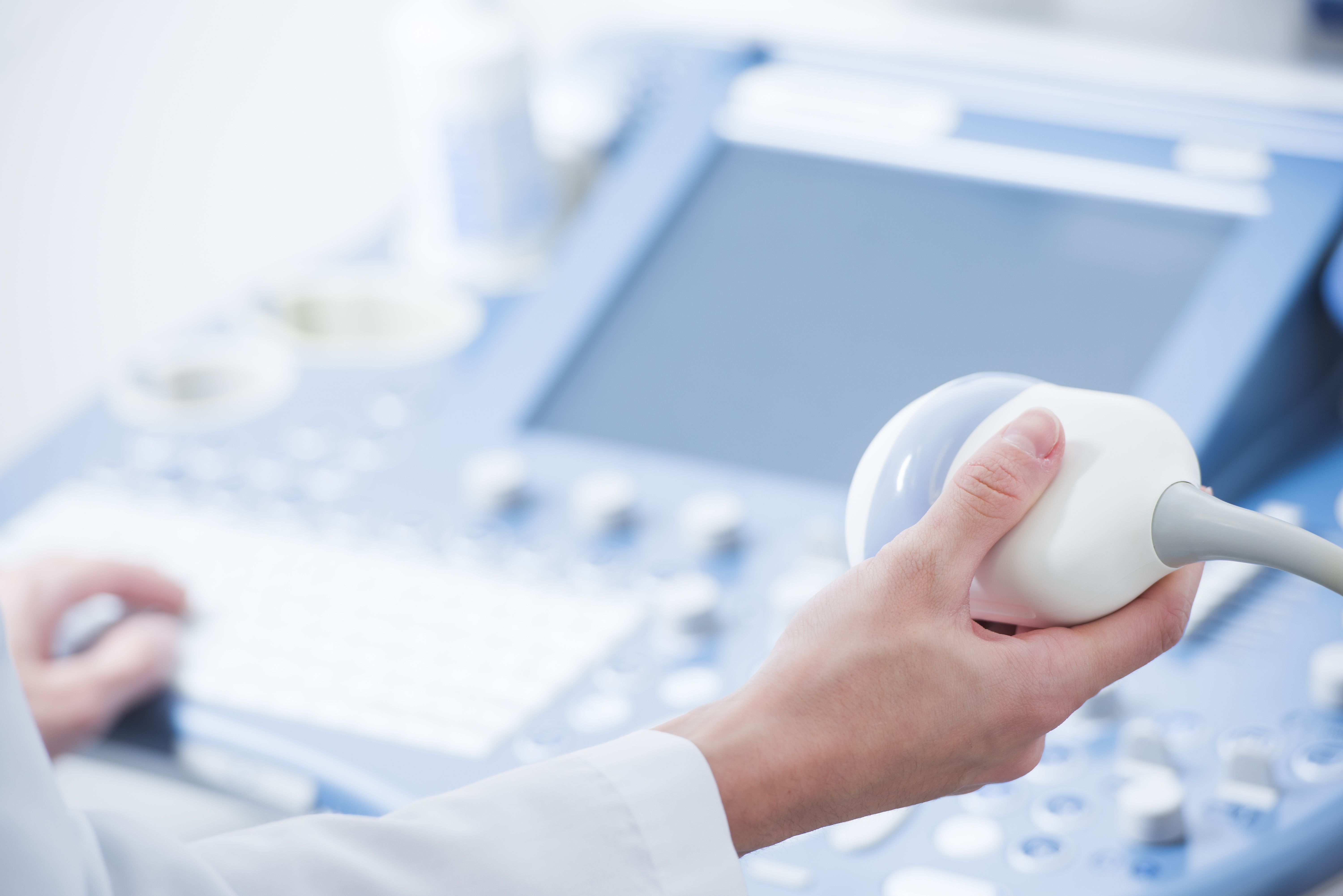Article
Ultrasound Features Can Help Inform Management of Gouty Arthritis
Author(s):
A retrospective analysis of nearly 150 patients with gouty arthritis in China provides further insight into the relationship between pathological ultrasound features and clinical signs and symptoms among this patient population.
Health care professional holding an ultrasound probe.
Credit: PhotoPlus

An ultrasonographic study of patients with gouty arthritis is offering rheumatologists and other health care professionals of the utility of musculoskeletal ultrasound as a clinical tool for diagnosis and management of gouty arthritis.1
Results of the study, which retrospectively assessed data from 139 patients with gouty arthritis, suggest pathological ultrasound features were more likely to be detected in patients with clinical signs and symptoms, with further analysis providing insight into the potential role of inflammation in gouty arthritis.1
“These results indicate that [gouty arthritis] patients with clinical signs and symptoms of active arthritis, were more likely to have detectable pathological ultrasound features, such as joint effusion, synovitis, [power Doppler ultrasonography], and bone erosion than in patients with inactive arthritis,” wrote investigators.1
As the Foshan, China-based team of investigators note, musculoskeletal ultrasound is a commonly used imaging modality for assessing gouty arthritis and mounting evidence has demonstrated the ability of power Doppler ultrasonography (PDS) to enhance the specificity of ultrasound. As a result, it has developed a role as a reliable method for assessing joint synovitis. However, investigators report an apparent lack of data on whether ultrasound features of the affected joints in gouty were associated with clinical symptoms of joint pain and dysfunction.
With this in mind, the team of investigators, which was led by Wenli Zheng, of the Department of Ultrasound Medicine at The Second People's Hospital of Foshan, designed the current study as a retrospective analysis of patient data recorded within the Department of Nephropathy and Rheumatology of The Second People’s Hospital from 2019-2022. For inclusion in the study, patients were required to meet the 2015 American Rheumatism Association and the European Union of Resistance Rheumatism joint definition of gout, have complete clinical data, and to have undergone an ultrasound examination including power Doppler analysis of the affected joint.1
In total, 139 patients were identified for inclusion. From this cohort, investigators obtained at a related to ultrasounds of 182 joints. Among this cohort, the most commonly involved joints were the metatarsophalangeal (32%), ankle (30%), knee (20%), phalangeal (7.1%), wrist (6.6%), and elbow joints (2.7%). Of the 182 joints included in the analysis, 134 met criteria for having active arthritis and 48 met criteria for inactive arthritis.1
For the purpose of analysis, synovitis, bone erosion, joint effusion, and PDS were each evaluated using a 4‐grade scale ranging from 0-3. Investigators noted plans for a correlation analysis use an rs value of 0-0.25 to indicate a weak correlation, 0.25-0.5 to indicate a fair correlation, 0.5-0.75 to indicate a moderate correlation, and greater than 0.75 to indicate a strong correlation.1
Upon analysis, results indicated the active arthritis group had a higher rate of joint effusion (P = .02), PDS (P=.001), double contour sign (P=.04), and bone erosion (P = .04) relative to the nonactive arthritis group, but investigators pointed out there was no statistically significant difference observed in regard to synovitis (P = .82), aggregates (P = .75), tophus (P = .22), and peritendinitis (P = .76).1
In their correlation analysis, investigators found joint effusion (rs = .275; P <.001) and PDS (rs = .269; P <.001) showed positive linear correlations with degree of pain, but no correlation was observed for degree of pain and other ultrasonic characteristics. Additionally, investigators highlighted statistically significant association was observed between PDS and joint effusion(rs = .281; P <.001), synovitis (rs = .271; P <.001), bone erosion (rs = .222; P = .003), and aggregation (rs = .281; P <.001). However, investigators also pointed out there were no statistically significant associations between PDS and any other ultrasonic characteristics.1
“This evidence further suggests that clinical manifestations of acute attack of [gouty arthritis] may be related to inflammation, reflecting the patient's condition to some extent and providing important reference information for the diagnosis and treatment, and also enhancing the confidence of clinicians in the management of [gouty arthritis] patients,” wrote investigators.1 “Therefore, musculoskeletal [ultrasound] can be used as a suitable tool for the management of [gouty arthritis] patients, and is worth popularizing.”
References:
- Zheng W, Lu P, Jiang D, Chen L, Li Y, Deng H. An ultrasonographic study of gouty arthritis: Synovitis and its relationship to clinical symptoms: A retrospective analysis. Health Sci Rep. 2023;6(6):e1312. Published 2023 Jun 7. doi:10.1002/hsr2.1312
- Amorese-O'Connell L, Gutierrez M, Reginato AM. General Applications of Ultrasound in Rheumatology Practice. Fed Pract. 2015;32(Suppl 12):8S-20S.





